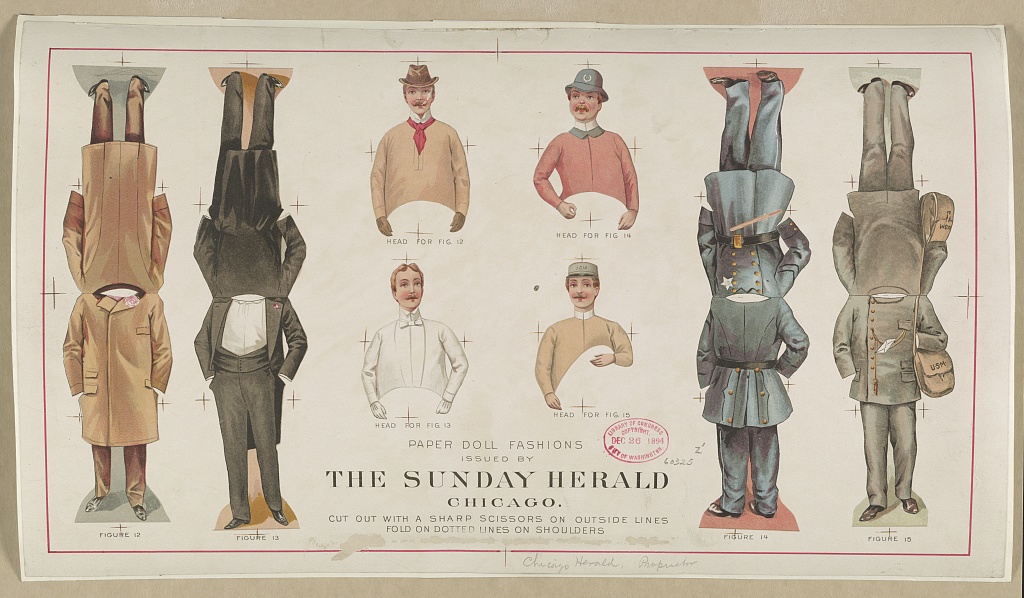Dressed Up in Paper: What Will I Be?
The origin story of the paper doll is steeped in speculation. This uncertainty is a testament to the broadness of the paper doll as a category. A paper doll can be commercial, commemorative, educational, or used for play, and the many forms a paper doll may take make it a fascinating, multidisciplinary object of study. Yet, it is through the combined forces of the history of paper and the history of playthings that led to the emergence of paper dolls in the mid-eighteenth century.
During the reign of Louis XV (1715-1774), the cost of printing and paper reached a point that permitted the large-scale production and consumption of printed matter, including paper dolls.[1] Figures such as Madame Pompadour and Madame du Barry sought out trinkets that were increasingly becoming staples in the lives of the wealthy, created for no other purpose than amusement. Paper puppets, or pantin, as they were then known—named after the Parisian suburb in which they were crafted—were cut out, strung together, and made to move. Pantin were painted as shepherds, milkmaids, and court personalities. Much like the figures who appeared in early French fashion plates,[2] these figures were drawn from contemporary life, and their carefully-chosen accessories served to round out their identities. Indeed, the earliest paper dolls were extremely individualized and were unable to be changed into different costumes.
Germany was the first region to develop flat sheets called Bilderbogen, or “picture sheets,” which required children to cut out both the doll and its accompanying wardrobe.[3] From that point on, cutting became integral to the paper doll experience. The introduction of the physical act of cutting changed the nature of play, becoming a necessary action for forging an intimate bond between a paper doll and its owner. First, a child had to carefully cut out their paper figure, along with every hat, dress, parasol, or purse—always mindful to not misdirect his or her scissors for fear of snipping off a ribbon or chopping away a petticoat hem. Once the figure and its clothes had been separated from the sheet, the paper garments would begin their slow deterioration: with each bend and fold, the fragile garment’s structure would be weakened.
The fragility of paper dolls goes hand-in-hand with the designer’s and illustrator’s affinitities for contemporary subjects. Always embedded in a perpetual now, paper dolls are mass-produced advertisements for the era in which they were created. Not only are they records of fashion trends, but also of the prevailing popular attitudes toward children, men, women, servants, and social classes. In the 1930s, Vanity Fair ran a paper doll series by the political cartoonist and illustrator Constantin Alajalov. The series included notable figures of the time such as Cornelia Otis Skinner, J.P Morgan, Ernest Hemingway, and Aimee Semple MacPherson. Alajalov’s series satirized his subjects’ appearances and character, and manifested their vices or virtues in the dolls’ wardrobes.
Over the years, paper dolls have also been utilized as a form of historical revivalism. In Charlotte, North Carolina in 1987, the Mint Museum’s Costume Collection developed a paper doll character named Emma Elizabeth. Jane Ellen Starnes designed the doll, and her wardrobe of five outfits depicted mid-nineteenth century pieces from the museum’s permanent collection.[4] While the physical act of “cutting along the dot[t]ed line” continues to prevail, Emma Elizabeth’s booklet also featured the inclusion of lengthy material descriptions for educational purposes. Focusing on the construction and materiality of garments, this is unlike the vast majority of paper dolls that focus on the activities of everyday life, and which require individuals to dress in specific ensembles to fulfill their roles within society.
There is a song that was featured in Alfred Hitchcock’s film The Man Who Knew Too Much titled “Que Sera, Sera.” For me, its most iconic stanza is: “When I was just a little girl, I asked my mother what will I be?” The question is innocent, direct, and determined, while the answer, “whatever will be, will be,” is crafted from adult compromises, experience, and uncertainty. The simple question and artfully mature answer is also the model for paper dolls. Whether the paper doll is a girl or boy, celebrity or historical figure, these “stylish” pieces are advertisements for the latest fashion trends. Beyond play, they are objects that have taught children, throughout time, how to dress for life.
Notes
[1] Anne Tolstoi Wallach, How to Find, Recognize, Buy, Collect, and Sell the Cutouts of Two Centuries (New York:Van Nostrand Reinhold Company, 1982), 10.
[2] For a discussion of early French fashion plates see Vyvyan Holland, Hand Coloured Fashion Plates 1770-1899 (London: Batsford, 1955).
[3] Wallach, 13.
[4] Starnes to Jean L. Druesedow, 1990, 8, March, with Emma Elizabeth: A mid-19th century paper doll gift, (New York: Metropolitan Museum of Art Costume Institute Library).



